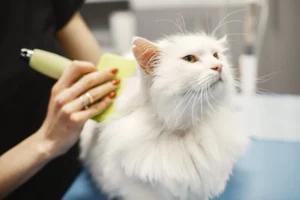Cats are known for their mysterious and sometimes unpredictable behavior. One day, you may notice a lump on your cat’s back, causing you to wonder what could be causing it. Understanding the reasons behind this phenomenon can help put your mind at ease and ensure your feline friend receives the care they need.
If you’ve ever found a lump on your cat’s back, you’re not alone. There are several reasons why your cat may develop a lump in this area. From abscesses to lipomas, it’s essential to identify the cause so you can address any underlying health issues your cat may be experiencing.
Is it an abscess?
If you’ve noticed a lump on your cat’s back, there’s a possibility it could be an abscess. Abscesses are pockets of pus that form in response to infection or inflammation. They can be caused by bites, scratches, or other injuries that introduce bacteria under the skin.
If you suspect the lump could be an abscess, it’s crucial to seek veterinary care promptly. Your vet will likely need to drain the abscess, clean the wound thoroughly, and possibly prescribe antibiotics to clear up any infection. Home treatment is not recommended as improper care can lead to further complications.
It’s essential to address an abscess promptly to prevent it from spreading or causing discomfort for your furry friend. Early intervention can help your cat recover quickly and prevent any long-term issues.
Extra Tip:
If your cat tends to roam outdoors and frequently gets into fights with other animals, consider keeping them indoors to reduce the risk of abscesses.
Could it be a lipoma?
When questioning why your cat has a lump on its back, one possibility to consider is a lipoma. Lipomas are benign fatty tumors that can develop under the skin. Unlike abscesses, lipomas are non-painful and slow-growing.
If the lump on your cat’s back feels soft and moveable, it could be a lipoma. These tumors are generally harmless and rarely require treatment. However, it’s always best to have your veterinarian evaluate any new lumps or bumps to confirm the diagnosis.
In most cases, lipomas do not pose a health risk to your cat, but it’s essential to monitor the lump for any changes in size or consistency. If you notice any abnormalities, consult your vet for further guidance.
Remember, staying informed and proactive about your cat’s health is key to ensuring their well-being and quality of life.
Is it a cyst?
If you’ve noticed a lump on your cat’s back, one possible explanation could be a cyst. Cysts are typically benign, fluid-filled sacs that can develop under the skin. They are usually not painful and can vary in size. To determine if the lump is indeed a cyst, your veterinarian may perform a fine-needle aspiration, where a small sample of the lump is extracted and examined under a microscope.
Treatment for a cyst usually involves monitoring the lump for changes in size or appearance. If the cyst grows or causes discomfort to your cat, your vet may recommend surgical removal. Remember, it’s always best to consult with a professional to accurately diagnose and address any lumps on your cat’s back.
Other potential causes
Apart from cysts, lumps on your cat’s back could also be caused by tumors or allergic reactions. Tumors can be either benign or malignant and may require biopsy or surgical removal for proper diagnosis and treatment. Allergic reactions, on the other hand, can result from various triggers like insect bites or contact with irritants.
If you notice a lump on your cat’s back, it’s essential to schedule a vet visit for a thorough examination. Your veterinarian can provide specific recommendations based on the underlying cause of the lump. Remember, early detection and intervention are key to ensuring the health and well-being of your feline friend.
When to see a vet
If you notice a lump on your cat’s back, keep an eye out for any changes in size, shape, or texture. Schedule a vet visit if the lump grows rapidly, becomes painful, or starts oozing. Other signs that it’s time to seek professional help include if the lump is causing your cat discomfort, interfering with their movement, or affecting their appetite. Remember, early detection and treatment are crucial for your cat’s health and well-being.
Home care tips
When dealing with a lump on your cat’s back, it’s essential to monitor it regularly for any changes. Check for signs of redness, swelling, or irritation around the lump. Provide your cat with a comfortable resting place and ensure they have access to fresh water and food. Avoid trying to diagnose the lump yourself or applying any home remedies without consulting a vet. Your furry friend deserves the best care possible, so don’t hesitate to seek professional help if needed.
Helpful tip: If your cat is uncomfortable with you touching or examining the lump, try using treats or their favorite toy to distract them during the process. This can make it easier for you to monitor the lump and assess any changes accurately.
For more information on lumps in cats and when to seek veterinary care, you can refer to the American Association of Feline Practitioners for additional resources and guidance.
Preventing lumps in cats
If you’re wondering how to keep your furry friend free from those pesky lumps on their back, here are some helpful tips to steer them in the right direction. First and foremost, proper grooming is key. Regular brushing not only keeps your cat looking sleek but also helps prevent hairballs and matting that can lead to lumps. Additionally, providing a well-balanced diet rich in essential nutrients can boost their immune system and overall health, reducing the likelihood of developing lumps. Lastly, don’t skip those routine veterinary check-ups. Your vet can catch any potential issues early on, preventing lumps or addressing them promptly if they do arise.
Interesting facts about lumps on cats
Curious about what causes those mysterious lumps on your beloved feline companion? While most lumps are benign, some may be a cause for concern. Rare conditions like feline infectious peritonitis or mast cell tumors can manifest as bumps on your cat’s skin. Remember, it’s always best to consult with your vet if you notice any unusual lumps or bumps on your cat. They can provide a proper diagnosis and recommend the appropriate course of action. In the meantime, keep an eye out for any changes in size, shape, or texture of the lumps, as this information can be valuable for your vet’s assessment.
- Fatty tumors: These benign growths are common in older cats and are typically harmless.
- Abscesses: Often caused by wounds or infections, abscesses can appear as painful lumps that need prompt treatment.
- Sebaceous cysts: These fluid-filled sacs can form under the skin and may require medical attention if they become infected.
- Insect bites: Sometimes a simple bug bite can cause a small lump or bump on your cat’s skin. Keeping your cat’s environment insect-free can help prevent these irritations.
- Cancer: While less common, certain types of cancer can present as lumps on your cat’s body. Regular veterinary exams are crucial for early detection and treatment if needed.
Remember, being proactive about your cat’s health and well-being is the best way to keep those lumps at bay. By staying informed and taking preventive measures, you can help your feline friend lead a long and healthy life.
Alex, a passionate animal lover, has experience in training and understanding animal behavior. As a proud pet parent to two dogs and three cats, he founded AnimalReport.net to share insights from animal experts and expand his knowledge of the animal kingdom.




